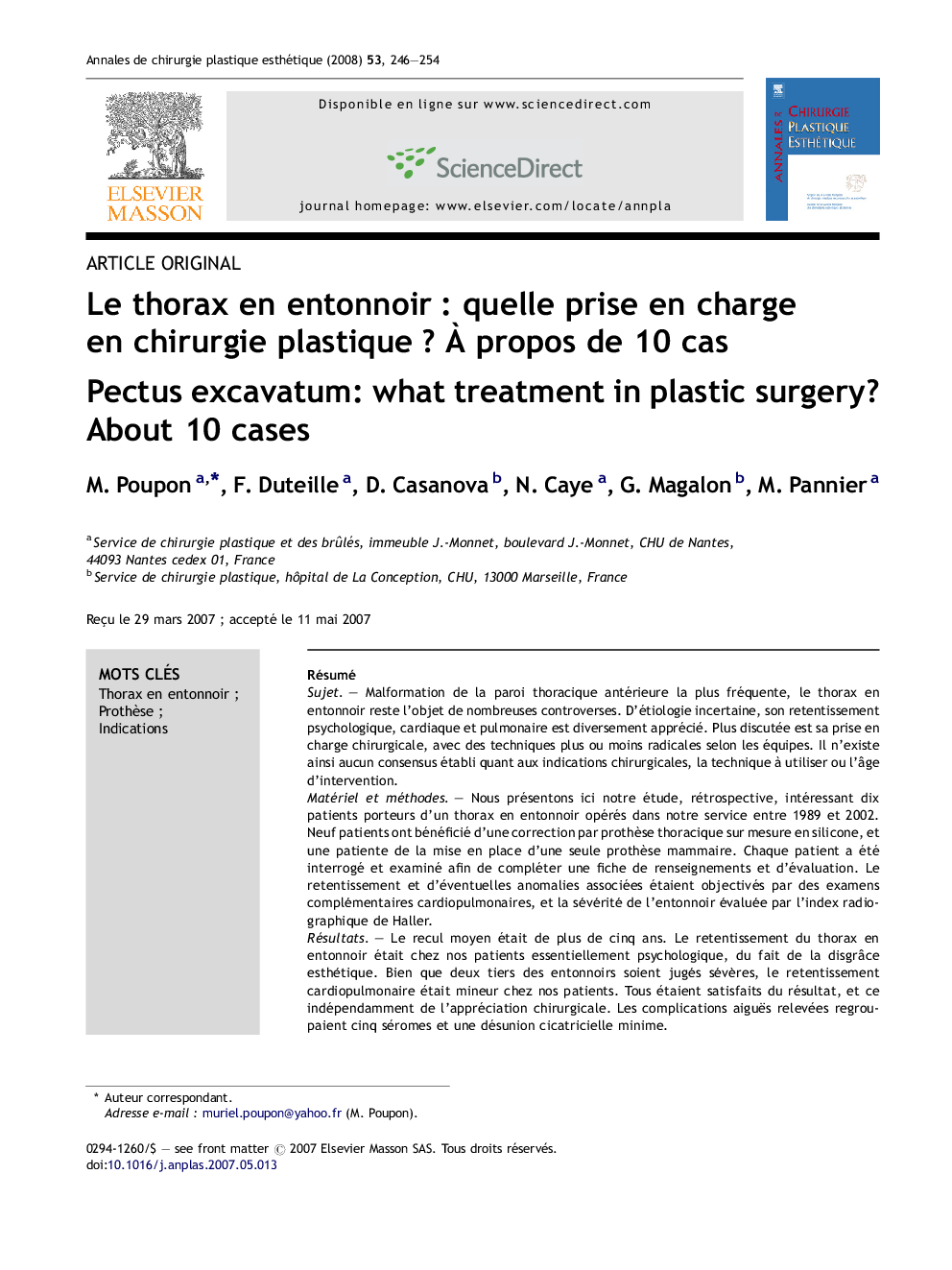| Article ID | Journal | Published Year | Pages | File Type |
|---|---|---|---|---|
| 3185208 | Annales de Chirurgie Plastique Esthétique | 2008 | 9 Pages |
RésuméSujetMalformation de la paroi thoracique antérieure la plus fréquente, le thorax en entonnoir reste l’objet de nombreuses controverses. D’étiologie incertaine, son retentissement psychologique, cardiaque et pulmonaire est diversement apprécié. Plus discutée est sa prise en charge chirurgicale, avec des techniques plus ou moins radicales selon les équipes. Il n’existe ainsi aucun consensus établi quant aux indications chirurgicales, la technique à utiliser ou l’âge d’intervention.Matériel et méthodesNous présentons ici notre étude, rétrospective, intéressant dix patients porteurs d’un thorax en entonnoir opérés dans notre service entre 1989 et 2002. Neuf patients ont bénéficié d’une correction par prothèse thoracique sur mesure en silicone, et une patiente de la mise en place d’une seule prothèse mammaire. Chaque patient a été interrogé et examiné afin de compléter une fiche de renseignements et d’évaluation. Le retentissement et d’éventuelles anomalies associées étaient objectivés par des examens complémentaires cardiopulmonaires, et la sévérité de l’entonnoir évaluée par l’index radiographique de Haller.RésultatsLe recul moyen était de plus de cinq ans. Le retentissement du thorax en entonnoir était chez nos patients essentiellement psychologique, du fait de la disgrâce esthétique. Bien que deux tiers des entonnoirs soient jugés sévères, le retentissement cardiopulmonaire était mineur chez nos patients. Tous étaient satisfaits du résultat, et ce indépendamment de l’appréciation chirurgicale. Les complications aiguës relevées regroupaient cinq séromes et une désunion cicatricielle minime.DiscussionAprès comparaison de nos résultats à ceux de la littérature, et au regard des différentes possibilités de traitement existantes (prothèse, sternochondroplastie, transfert graisseux), les indications et les modalités de prise en charge chirurgicale du thorax en entonnoir sont discutées.
SubjectSeveral controversial issues concern pectus excavatum (funnel chest), the most common chest wall deformity. The pathogenesis of this deformity is uncertain, and there is no agreement as to its psychological, cardiac and pulmonary effects. An even more debatable point is the choice of surgical treatment among the more or less radical proposals made by different teams. No consensus exists concerning the indications for surgery, the technique to be used, or the suitable age of the patient.Materials and methodsThis retrospective study concerns 10 patients with funnel chest who underwent reconstruction surgery in our unit between 1989 and 2002. Nine patients received a silicone chest implant made to measure, and one a single breast implant. Each patient was interviewed and examined to obtain information and provide a basis for evaluation. The effects of possible associated abnormalities were evidenced by complementary cardiopulmonary examinations, and the severity of funnel chest was evaluated according to the Haller pectus index.ResultsThe mean period after surgery was 5 years. The effects of funnel chest deformity were essentially psychological, relating to aesthetic disgrace. Although two-thirds of the deformities were considered severe, cardiopulmonary repercussions were minor. All 10 patients were satisfied with the repair performed, and this judgment was independent of surgical assessment. Acute complications concerned 5 seromas and one minimal scar separation.DiscussionThe indications for surgery and the means of surgical treatment for funnel chest are considered after comparison of our results with those in the literature and a survey of the different existing possibilities for treatment (implant, chondrosternoplasty, fat transplant).
